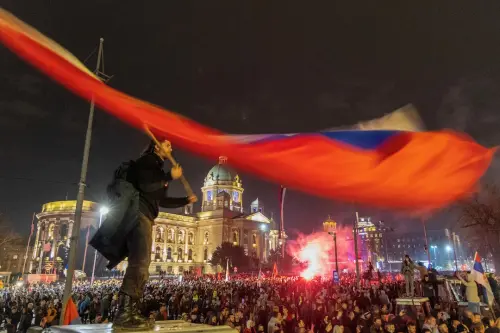Tamara Bojanovski was in a crowd of anti-government protesters on March 15 when she heard a sound "like some powerful machine hurtling up from behind." Thousands of others experienced the same sensation; the crowd, packed into one of Belgrade's main boulevards, abruptly parted and rushed to the sidewalks.
Stefan, a student, described a "rumble," followed by a "whoosh" and a feeling of something speeding toward the crowd. Another student, Dragica, felt "a wave travelling through us."
"People felt faint, and some fell over," recalled lawyer Bozo Prelevic, a former joint interior minister. The noise lasted only a few seconds but has sparked speculation that a sonic weapon was used illegally to disperse the rally. President Aleksandar Vucic, already facing longstanding civil protests, is under pressure to clarify the incident.
Sonic weapons use extreme sound to incapacitate targets, potentially causing ear damage, headaches, and nausea. Their use is illegal in Serbia. Authorities initially denied having such devices, but Interior Minister Ivica Dacic later acknowledged that police had acquired Long-Range Acoustic Devices (LRADs) from the U.S. in 2021. Following this, the Serbian police, BIA security and intelligence agency, and military all denied ever using them in public.
Vucic stated that Russia had sent experts from its FSB intelligence service to investigate at Belgrade's request, and American FBI investigators would also arrive within days. The U.S. Department of Justice did not respond to inquiries.
The Omega Foundation, a human rights watchdog, reviewed photos, witness accounts, and audiovisual footage, finding them inconclusive but suggesting that an LRAD could have been involved. "We really haven't seen an effect like this. It was so distinctive," said Omega Foundation researcher Neil Corney.
Earshot, a non-profit organization specializing in audio investigations, suggested the noise might have originated from a vortex ring gun, an experimental non-lethal weapon for crowd control that uses high-energy doughnut-shaped vortices of air or gas, though they emphasized the need for further research. Meanwhile, U.S.-based Genasys, the manufacturer of LRADs, claimed that the audio and video evidence "does not support the use of an LRAD."
The protesters had gathered to honor 15 individuals who died when a train station roof collapsed in Novi Sad. Many attribute this tragedy to government corruption and poor construction, which has mobilized hundreds of thousands onto the streets and increased pressure on Prime Minister Milos Vucevic, as well as on Vucic.
Geolocation of the videos indicates that the sound wave traveled south along Kralja Milana Street for over 500 meters. "The street emptied ... like when Moses parted the Red Sea," remarked Zoran Radovanovic, an epidemiologist present in the crowd.
